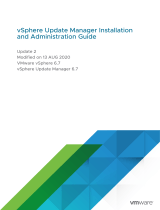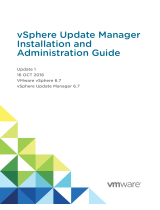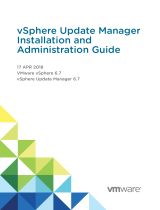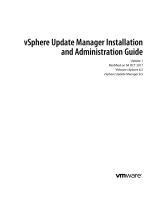
Upgrade readiness for PowerStore X model appliances
Before upgrading, review the following considerations:
• You can learn that an upgrade is available in one of the following ways:
○ If you are using SupportAssist with your PowerStore appliance, PowerStore Manager notifies you when an upgrade is available.
○ If you are not using SupportAssist, or do not have SupportAssist connected to your PowerStore appliance, go to www.dell.com/
support and check for an upgrade.
• A few days before upgrading, upload the PowerStore OS image file that you want to install and perform a system health check on it.
The health check ensures that there are no underlying problems that may prevent a successful upgrade, such as:
○ A faulted hardware component
○ An incompatible vCenter software version
• There can be up to ten upgrade candidates of different types on the system at a time. However, after an upgrade starts, it must
successfully complete across all appliances in the cluster before another upgrade can be performed.
• You cannot make configuration changes to the system while the upgrade is in progress.
• Applying an upgrade does not stop I/O. The nondisruptive upgrade process uses redundant paths, ensuring that no more than one
node is taken offline at any given time. Either node in your appliance can satisfy I/O requirements.
ESXi and VM considerations
Before upgrading, run a health check to determine whether there is a prerequisite PowerStore node firmware or ESXi update. Depending
on which components are upgraded, the duration of the required maintenance window and whether an upgrade requires any downtime
varies. For details and time estimates, see the PowerStore Release Notes.
In general, vSphere automatically migrates VMs that are running on a PowerStore X model appliance as necessary to keep them available
during the upgrade. However, manual intervention may be required if one of the following conditions exists:
• The VMs running on ESXi hosts or VM disks point to the local ESXi host drives
• The total amount of memory or CPU usage across the VMs exceeds the amount available on a single node
• The VMs cannot be migrated automatically because of a different reason
If any of these conditions occur, resolve the situation with one of the following options:
• Migrate the VMs to other available hosts
• Reduce the CPU or memory reservation requirements for the VMs
• Shut down the VMs
NOTE:
Any VMs that are migrated as a part of the upgrade process are not automatically migrated back to their original
location after the upgrade is complete.
Minimizing failover occurrences
If the upgrade includes new versions of the PowerStore node firmware or ESXi, each ESXi host in the appliance must be placed into
Maintenance Mode during the upgrade process.
When the ESXi host that is running PowerStore OS enters Maintenance Mode, the user VMs migrate to the ESXI host on the other node
of the appliance. The appliance is temporarily unable to display PowerStore Manager or act as a VASA provider until the failover process
between nodes is complete.
To minimize disruptions caused by failover, start the upgrade on the ESXi host on the peer node of the appliance.
Use PowerStore Manager to identify the peer node of the appliance:
1. From the Hardware page, click the name of the appliance, and then click the Hardware tab.
2. Click the Internal View tab.
The node without the text (primary) is the peer node.
3. Record the node letter of peer node, which is either A or B.
4. In PowerStore Manager, from the Compute > vCenter Server Connection page, start the vSphere Web Client by clicking LAUNCH
VSPHERE.
5. Log in to the associated vCenter Server.
6. Find the VM named PSTX-
<serial_number>
-
<node_letter>
.
Where node_letter is the node letter of the peer node that was recorded in step 3.
7. On the Summary tab of the VM, record the Host IP address.
This address is the IP address of the ESXi host on the peer node of the appliance.
Dell EMC PowerStore Software Upgrade Guide
3










